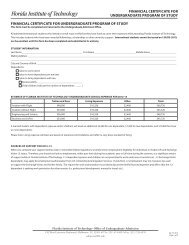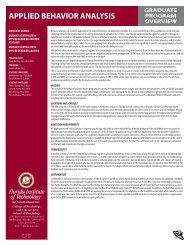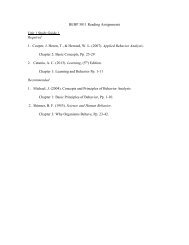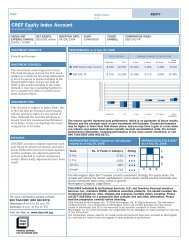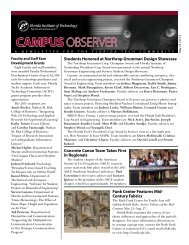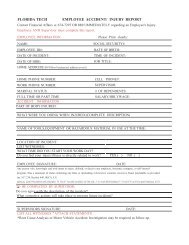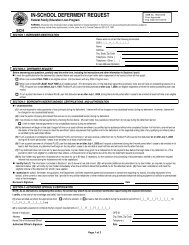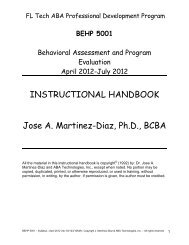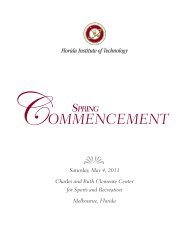2013–2014 UNIVERSITY CATALOG - Florida Institute of Technology
2013–2014 UNIVERSITY CATALOG - Florida Institute of Technology
2013–2014 UNIVERSITY CATALOG - Florida Institute of Technology
Create successful ePaper yourself
Turn your PDF publications into a flip-book with our unique Google optimized e-Paper software.
RESEARCH<br />
Current areas <strong>of</strong> research include image processing, electromagnetics,<br />
computer vision, neural networks, speech processing, wireless communications<br />
and pattern recognition. These activities are being carried<br />
out in relation to the following general areas <strong>of</strong> research interest.<br />
Electromagnetics: Applied and computational research is conducted<br />
in order to manipulate electromagnetic fields. Antennas, frequency<br />
selective surfaces, high impedance ground planes, and bandgap<br />
structures are designed and analyzed using computational tools, then<br />
tested for validation. The ability to model electromagnetic properties<br />
<strong>of</strong> complex structures requires full-wave analysis with finite element,<br />
method <strong>of</strong> moments or finite difference techniques. RF measurements<br />
are conducted in the antenna laboratory that houses an anechoic<br />
chamber and screen room.<br />
Image processing: Much <strong>of</strong> the research is directed at basic problems<br />
and contributes to the solution <strong>of</strong> major national problems in vision<br />
and image processing. These include automated object detection and<br />
perception, computer imaging, modeling and other areas <strong>of</strong> image<br />
analysis. Techniques being used include traditional techniques and<br />
others that include wavelets, fractals, higher-order statistics and morphology.<br />
Application areas include autonomous inspection in manufacturing<br />
and other commercial uses. Projects include the fusion <strong>of</strong><br />
infrared and visible imagery, and denoising <strong>of</strong> imagery using advanced<br />
methods. In addition, many <strong>of</strong> the techniques in image processing<br />
are being applied to speech processing.<br />
Lightwave and Optronics Laboratories: The laboratories are dedicated<br />
to research and development efforts in the field <strong>of</strong> optical electronics<br />
such as optical communications and optical sensors. Activities<br />
with regards to communication span the development <strong>of</strong> state-<strong>of</strong>the-art<br />
multi-Tb/s optical transmission architectures to design and<br />
development <strong>of</strong> cryogenic instrumentation for the space program.<br />
Current activities are focused on innovative optical communications<br />
architectures such as spatial and orbital angular momentum (OAM)<br />
photon-based, multiplexing in optical fibers. As a result, revolutionary<br />
capabilities for future optical networks using hybrid architectures<br />
have already started to emerge and several multi-Tb/s optical systems<br />
employing multiple photon degrees <strong>of</strong> freedom were recently reported.<br />
Sensor research includes 2-D and 3-D structural health monitoring<br />
<strong>of</strong> strain and material failure, and environmental parameters. These<br />
laboratories are equipped with instrumentation such as tunable lasers,<br />
optical spectrum analyzers, bit error rate test sets, fiber amplifiers and<br />
digitally controlled attenuators, optical time domain reflectometers,<br />
fiber splicers and customized data processing systems for data acquisition<br />
and signal processing.<br />
Signal processing: Research is performed in neural networks, image<br />
processing, pattern recognition and speech processing. Algorithms<br />
have been developed for near-real-time detection and classification<br />
for several applications such as communications, noise reduction,<br />
and speaker identification. Techniques being used include traditional<br />
techniques and others that include wavelets, fractals, higher-order statistics<br />
and morphology. Projects include the analysis and classification<br />
<strong>of</strong> infrasound signals, development <strong>of</strong> pattern recognizers, denoising<br />
<strong>of</strong> imagery and speech identification.<br />
Wireless Center <strong>of</strong> Excellence (WICE): See the Institution Overview<br />
section. Research within WICE focuses on areas related to wireless<br />
communication, wireless multimedia communications and wireless<br />
sensor systems. Students are involved in research projects evaluating<br />
122 <strong>Florida</strong> Tech <strong>2013–2014</strong><br />
propagation <strong>of</strong> radio waves, planning and optimization <strong>of</strong> voice and<br />
data services in cellular systems, various aspects associated with<br />
wireless sensor networks and topics addressing challenges in providing<br />
multimedia communication over wireless links. WICE is well<br />
connected with several industry partners that help in selection <strong>of</strong><br />
relevant research topics and provide the center with state-<strong>of</strong>-the-art<br />
design tools and CAD s<strong>of</strong>tware. In recent years the center has been<br />
involved in the hurricane research program sponsored by the National<br />
Science Foundation.<br />
DEPARTMENT OF ENGINEERING SYSTEMS<br />
Muzaffar A. Shaikh, Ph.D., Head<br />
Degree Programs<br />
Engineering Management, M.S.<br />
Systems Engineering, M.S., Ph.D.<br />
Graduate Certificate in Enterprise Architecture<br />
Pr<strong>of</strong>essors<br />
William W. Arrasmith, Ph.D., systems engineering, signal processing.<br />
Muzaffar A. Shaikh, Ph.D., management science, decision modeling,<br />
mathematical programming, management information systems, systems<br />
engineering, operations research.<br />
Assistant Pr<strong>of</strong>essors<br />
Luis D. Otero, Ph.D., system design and analysis, industrial systems<br />
engineering.<br />
Adrian M. Peter, Ph.D., systems engineering, statistical data analysis,<br />
machine learning, image analysis.<br />
Barry Webster, Ph.D., systems engineering, optimization analysis,<br />
management and analysis <strong>of</strong> data, artificial intelligence, s<strong>of</strong>tware engineering.<br />
Adjunct Faculty<br />
M.W. Grieves, E.D.M.; K.J. Wallenstein, Ph.D.; R.W. Welch, Ph.D.<br />
Mission Statement<br />
The mission <strong>of</strong> the department <strong>of</strong> engineering systems is to prepare<br />
engineers and scientists for leadership roles in business organizations.<br />
Our educational objectives are to achieve steady enrollment<br />
growth and pursue practical funded research; to provide engineers<br />
and scientists the skills to expand their areas <strong>of</strong> responsibility in the<br />
workplace; and to update the skills <strong>of</strong> engineers and scientists in their<br />
fields <strong>of</strong> specialization.<br />
Undergraduate Area <strong>of</strong> Emphasis in Systems Engineering<br />
This area <strong>of</strong> emphasis is designed to expose interested undergraduate<br />
engineering students to core aspects <strong>of</strong> systems engineering. Juniors<br />
and seniors within the College <strong>of</strong> Engineering can select any three<br />
from the four courses listed below and have them applied as electives:<br />
SYS 4100 Quality Engineering<br />
SYS 4200 Project Engineering<br />
SYS 4310 Systems Engineering Principles<br />
SYS 4460 Systems Requirements Analysis<br />
Undergraduate students in the Fast Track Master’s Program for<br />
College <strong>of</strong> Engineering Honors Students can take up to two <strong>of</strong> the<br />
courses under the graduate-level number (listed below). In this case,<br />
requirements for the fast track program apply. As a general rule, fast<br />
track students may apply up to six credits to both the undergraduate<br />
and graduate degree.<br />
ENM 5100 Quality Engineering<br />
ENM 5200 Project Engineering<br />
SYS 5310 Systems Engineering Principles<br />
SYS 5460 Systems Requirements Analysis




